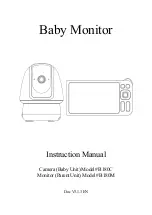
12
2.1 Installation Site Requirements
If the site requires modifications or special preparations for installation of the plasma display or its mounting hardware,
obtain permission in advance from the building owner or building authorities. To ensure installations safety, it is also
important to determine the strength of the installation site with the help of the original building contractor.
Safety Precautions
1) Structure of the installation site
Make sure you thoroughly understand the structure of the installation site before determining the most suitable installation
method. Buildings vary in structure and materials, and the appropriate mounting hardware with differ accordingly. When
drilling into walls, always remain aware of the internal electric wiring and pipes.
2) Weight capacity of the installation site
Select a location with a weight capacity sufficient to support the total weight of the display and mounting hardware.
3) Flat, level surfaces
Select a flat, level surface for installation, such that mounting software will be parallel to the surface to which it is affixed.
Install the unit so that the load is evenly distributed along the ceiling or floor, as well as on mounting hardware such as hang
bolts.
4) Sufficient work space
Select a location with sufficient space for installation work.
5) Nearby equipment
If air conditioning ducts or lamps, etc. are located near the installation site, the attendant dust, extreme temperatures,
humidity, and condensation may become sources of trouble. Please take sufficient steps to avoid this.
6) Safe locations
Do not install the unit where it may be easily touched or leaned against. Avoid locations subject to high vibration or severe
impacts.
7) Lighting conditions
• Consider existing lighting and sunlight angles when creating the installation layout. Extremely bright lighting can reduce
the visibility and quality of the display image.
• In extremely bright surroundings, adjusting screen intensity may not result in perceptibly brighter images. Keep in mind
that extreme intensity settings can reduce system service life.
8) Other installation conditions
The unit is designed for indoor use, and is not suited for open-air use. Installation in locations that are even partially exposed
to the elements may lead to malfunctions or breakdown caused by any of the following. And if there is danger of it being
exposed to similar effects even when installed indoors, it is necessary to block the outside air by cooling the casing etc.
• Water and dust
• Changes in temperature and humidity
• Salt-bearing wind
Direct sunlight upon the display degrades image quality. In installing the display, avoid sites exposed to direct sunlight.
9) Temperature and humidity conditions
• The installation site should meet the following conditions:
•
Operating temperatures: 0 to 40 °C (largely depending on installation conditions)
•
Operating humidity: 20 to 80 %
•
Storage temperature: –10 to 50 °C
•
Storage humidity: 10 to 90 %
•
Operating atmospheric pressure: 720 to 1114 hPa
•
Storage atmospheric pressure: 700 to 1114 hPa
• We recommend against installing electronic products such as this unit in locations subject to high humidity. If the unit is
to be installed in a location subject to relatively high humidity, observe the following:
•
Failure to install the unit in unacceptable ways may result in non-warranty damages.
•
Make sure the unit is grounded.
•
Do not allow water or other liquids to enter the unit.
Installation Site Requirements













































